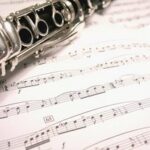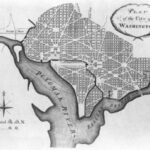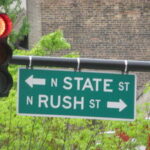Robert Rauschenberg, the “father of Pop,” creates works of art by arranging photographs and mixed-medias with methods of “chance and indeterminacy [Gardner, 1059].” The appearances of his paintings give the viewer a sense that the world and America, although chaotic, can maintain equilibrium. His painting, entitled “Estate,” shows equality and coexistence through a street scene in New York City. Typical creations by him also reflect this essence through his unusual techniques, which originate from influential artists and his personal, and often unconscious, artistic decisions.
Many of the techniques as well as opinions Rauschenberg utilizes come from the influence of composer John Cage. His idea that art should directly link to life and the self persuaded Rauschenberg to create works that displayed ordinary scenes in extraordinary ways. In his own work, Cage tried to avoid the format normally used when creating musical compositions of that time period. Rauschenberg applies a parallel approach with his art form by starting a new and unconventional style, Pop Art. Cage also believed that art should be a direct link to life itself, a theory Rauschenberg firmly practiced. Although his paintings do not seem to be the most direct link, their abstract nature reflects the disorder of America.
Cage, who praised Rauschenberg’s art and appreciated his admiration, once said, “There is no more subject in a combine [by Rauschenberg] than there is in a page from a newspaper. Each thing that is there is a subject. It is a situation involving multiplicity [Gardner, 1059].” When comparing the different combines (a.k.a. collages) by Rauschenberg, one will notice no people present among the semblance. The absence of the human form shows a judgment unconsciously added to the element of the artwork: Rauschenberg dislikes people and holds fixed objects at a higher value. However, the objects incorporated in the paintings often express a more abstract idea. For example, in the piece entitled “Reservoir” (completed in 1961), clocks placed at opposite vertical ends of the canvas become two separate focal points. One clock recorded the time at which he began to paint and the other the time at which he finished [Phaidon, 378]. Even though Rauschenberg claims to have begun painting with a unique style in order to abandon conventional America, the clocks in “Reservoir” unintentionally reflect the importance he possesses over the concept of time. His own words “… [That art] takes its form from the lines of life, twists and extends impossibly and accumulates and spits and drips and is as sweet and stupid as life itself [Gardner, 1060],” best describe the creative drive and deeper significance behind his works of art.
The work of art “Estate,” completed in 1963, reflects the typical format, techniques, and appearance of Rauschenberg’s other works. Like his other pop-art creations, “Estate” is a collage displaying a variety of medias. The random images, often photographs taken from magazines or art books, connect with the surrounding painted objects as well as abstract shapes. The color schemes Rauschenberg chooses vary dramatically from painting to painting, expressing that the components of America also vary. The two-dimensional perspectives of the majority of his works allow the viewer to transform into the observer of an irregular, eccentric universe. This technique reflects the notion that America’s filled with peculiar, yet familiar, objects and sequence of events. Estate” in particular allows the viewer to observe a New York City scene and become a part of its disorder.
The choice to work with mixed-medias reflects the belief that every aspect of art is equally important. The painting “Estate” includes photographs of the Statue of Liberty, the Sistine Chapel, apartment buildings, and common items that would be seen when walking down the streets of New York. The combination of each of these images provides a sense of familiarity; first, the Statue of Liberty, symbolic to any American; second, the Sistine Chapel, a connection to a world-renowned, influential artist; and lastly, the apartments and street signs, commonplace to anyone living in an American metropolis.
To link the images together, Rauschenberg adds splotches of paint between them. The choice to use the colors red, blue, yellow, and white in the painting “Estate” produce a link back to the most basic principles of art. When properly mixed, the three primary colors and white create the pallet of colors all artists use, making them a common starting point when conceptualizing and developing a painting. Rauschenberg prominently uses these four colors to connect random images to create balance, an unconscious display of his beliefs and hopes for coexistence throughout the world. The lack of one focal point in “Estate” as well as other typical Rauschenberg masterpieces reinforces the sense of equality pertaining to each individual object.
Rauschenberg’s use of multiple medias helps define the world, including America, as a complex combination of situations, objects, and events. These interminglings create, through random images, the ability to coexist and belong. The balance and sense of belonging portrayed by his paintings reflect Rauschenberg’s talent to artistically pull everything together as well as the universe’s ability to maintain stability throughout all its components. However, in America humankind, who seek self-pleasure rather than the preservation of equality, often forfeit the sentiment of stability.
Gardner. Art through the Ages: Ninth Addition. New York: HBJ Publishers, 1991.
Phaidon. The Art Book. London: Phaidon Press Limited, 1994.





